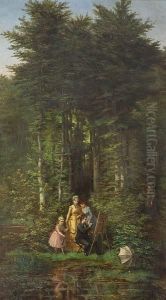Edgard Baes Paintings
Edgard Baes was a Belgian architect, painter, and etcher whose work is less widely known but contributes significantly to the understanding of early 20th-century Belgian art and architecture. Born in Antwerp in 1874, Baes grew up in a period marked by rapid industrialization and the emergence of new art movements which would influence his later work. He pursued his education in the arts at the Royal Academy of Fine Arts in Antwerp, where he was exposed to a variety of artistic styles and philosophies.
Baes's career was characterized by a diverse range of projects and interests. As an architect, he was known for his attention to detail and his ability to blend traditional Belgian architectural elements with the emerging Art Nouveau style, which was gaining popularity in Belgium and across Europe at the turn of the century. His architectural works, though not as prolific as those of his contemporaries such as Victor Horta or Henry van de Velde, demonstrated a keen understanding of space, light, and organic forms.
In addition to his architectural endeavors, Baes was a skilled painter and etcher. His paintings often depicted serene landscapes, urban scenes, and occasionally, portraits, showcasing his versatility and keen eye for detail. His etchings, on the other hand, allowed him to explore different textures and shades, creating works that were both intricate and expressive. These works, while not groundbreaking, contribute valuable insights into the stylistic transitions and artistic explorations of his time.
Throughout his career, Edgard Baes remained relatively obscure compared to his more famous contemporaries. However, his contributions to Belgian art and architecture have slowly gained recognition. His ability to navigate between different mediums and styles, from the architectural to the pictorial, showcases his versatility as an artist and his commitment to exploring the boundaries of artistic expression. Baes passed away in 1954, leaving behind a body of work that, while not extensive, provides a fascinating glimpse into the artistic landscape of early 20th-century Belgium.
